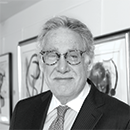I have worked for more than 35 years to build Galerie Michael, a prestigious, world-class gallery on Rodeo Drive in Beverly Hills. I attribute much of my success and legacy to my unusual business model: Rather than being a point of purchase gallery that emphasizes immediate sales, I strive to build museum-quality collections one work at a time. The types of client that use Galerie Michael’s services are corporations, universities, and high-net-worth individuals across the world. Galerie Michael puts together top level collections that have been exhibited and shared with more than 25 museums throughout the United States and the Europe. It is a way for collectors and Galerie Michael alike to give something of meaning back to the public.
Being a fine art dealer for over four and a half decades, I’ve acquired art all over the world. While recently attending an auction in Europe, a particular catalog entry caught my eye. It read, “A Petite Masterpiece by Monet: Haystack at Dusk.” The provenance stated that the piece came from Claude Aubrey and was subsequently placed with a gentleman in London.
Claude Aubrey was a great Parisian dealer of Petite Masters. As fate would have it, he was my first mentor. I met Claude on my very first sojourn to Paris. He was situated on a street adjacent to the River Seine amongst dealers who sold everything from fine antiques to Impressionist and Modern paintings. As a new American art dealer, I was taken aback by the arrogance, attempts of intimidation, and cavalier attitudes of the French galerists I met that day. Somewhat disheartened, I stumbled upon a warmly lit gallery with a well weathered sign that read “Galerie Claude Aubrey: Specializing in Petite Masters Works by Impressionist and Modern Artists.”
It appeared more inviting than the other galleries I visited. Walking through the door, I observed the walls were hung with petite paintings in tasteful antique gold frames from artists such as Picasso, Corot, Pissarro, etc. A stunning painting by Díaz de la Peña, Renoir’s mentor, was perfectly lit and glowed like a faceted jewel. Just to the right of it was a massive Louis the 14th desk behind which sat an elegantly dressed man in his early fifties. He appeared to be in an animated conversation on a large, classic red telephone.
After the off-putting treatment I had experienced, I assumed I would get more of the same. As I turned to walk out, he looked up and saw that I was leaving. Without further adieu and speaking in perfect English, he said, “Young gentleman, you can’t leave, you haven’t even seen my newest masterpiece.” His gracious attitude and enthusiasm took me aback. Getting up from his desk, he grabbed my arm, and directed me to an easel with a painting covered in red velvet. He pulled off the velvet and exclaimed, “Voilá!” It was a Monet haystack painting that shimmered like a rare gem in that late afternoon light.
“And what is the price of your petite Monet?” I inquired.
Claude responded by asking another question: “What is your name, young gentleman?”
“My name is Michael, Sir.”
“I’m not Sir; henceforth you may call me Claude. And as a new dealer, you’ve got lots to learn. Good fortune is with you today because I have a lot to teach. To be a great art dealer is to teach your clients about art and not selling. Michel. It’s critical to guide your clients to quality art that will be a permanent part of art history.” He went on for over two hours, sharing the philosophies and dealing ethics responsible for his success. That day he insisted I spend $150,000 and commit to one great painting, his Monet Haystack.
“Claude,” I explained, “I need to acquire at least thirty works to stock my new gallery, not just one.”
“No, no, no Michel. One great work is easier to place than thirty lesser ones.”
“But Sir—really? One work in 2,500 feet of gallery space?”
“Yes. One Monet in your gallery will be a cause célèbre. Americans will be aghast, just the perfect amount of irreverence.”
“But Claude, I don’t have $150,000 to spare, I’ve spent much of my budget already.”
I didn’t buy the Monet that day but left enthused by my burgeoning friendship. However, I did acquire several other paintings after he patiently explained and assured me that their quality would make them a permanent part of art history. Claude convinced me not to buy works that are in fashion because fashionable works, though easy to sell, can just as easily go out of fashion. He taught me to always be unpretentious, place your collector’s needs first, and to work from posterity and not prosperity. Guiding your clients to works of top quality is the most prudent way to direct them toward art that stands for quality and can accrue maximum value.
As I took my seat at the auction, the memory of that Monet and special day with Claude made me wish I had taken his advice: “Michel, beg, borrow, and steal, you must get the Monet.” Indeed it was a Petite Masterpiece, an unquestionable work of quality that will always be a permanent part of art history. As the painting came up I remembered its price of only $150,000. I was pleasantly surprised to see its current value, which was estimated between $3.5 and $4 million.














































